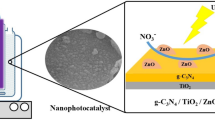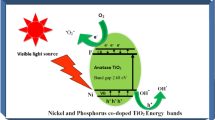Abstract
The degradation of nitroaromatics/toxic energetic compounds contaminated water is a major cause of concern. W-doped TiO2 nanoparticles (NPs) were synthesized in ionic liquid, ethyl methyl imidazolium dicyanamide (EMIM-DCA) by a solvothermal method. The developed NPs were sintered at 500 °C and characterized by UV-Vis-DRS, FT-IR, FE-SEM, XRD, XPS, and BET techniques. The 30–40-nm-sized NPs were subjected to photocatalytic degradation of the toxic energetic compound, tetryl (2,4,6-trinitrophenylmethylnitramine) under UV-Vis light. Various operating parameters such as the effect of concentration of catalyst, pH of feed phase, oxidizing agents, and recycling of catalyst were studied in detail. For the first time, the degradation-mechanism pathway and kinetics of tetryl were evaluated. The degradation products were precisely analyzed by using HPLC, GC-MS, and TOC techniques. The USEPA has prescribed a drinking water limit of 0.02 mg L−1, and it was found that 0.5 g of 4% W-TiO2 could totally degrade tetryl (50 mg L−1) within 8 h. The kinetic rate constant of 4% W-TiO2 was 0.356 h−1, whereas pure TiO2 showed 0.207 h−1.
Graphical abstract












Similar content being viewed by others
Data availability
The data and materials are true and reliable.
References
Akpan UG, Hameed BH (2009) Parameters affecting the photocatalytic degradation of dyes using TiO2-based photocatalysts: A review. J Hazar Mater 170:520–529
Alammar T, Noei H, Wang Y, Mudring MV (2013) Mild yet phase-selective preparation of TiO2 nanoparticles from ionic liquids– a critical study. Nanoscale 5:8045
Asanuma T, Matsutani T, Liu C, Mihara T, Kiuchi M (2004) Structural and optical properties of titanium dioxide films deposited by reactive magnetron sputtering in pure oxygen plasma. J Appl Phys 95:6011
Ayoub K, Hullebusch ED, Cassir M, Bermond A (2010) Application of advanced oxidation processes for TNT removal: A review. J HazarMater 178:10–28
Babuponnusami A, Muthukumar KA (2014) A review on Fenton and improvements to the Fenton process for wastewater treatment. J Environ Chem Eng 2:557–572
Best EP, Sprecher SL, Larson SL, Fredrickson HL, Bader DF (1999) Environmental behaviour of explosives in groundwater from the Milan army ammunition plant in aquatic and wet land plant treatments. Removal, mass balances and fate in groundwater of TNT and RDX. Chemosphere 38:3383–3396
Bhosale VK, Kulkarni PS (2016) Hypergolic behavior of pyridinium salts containing cyanoborohydride and dicyanamide anions with oxidizer RFNA. Propellants Explos Pyrotechnics 41(6):1013–1019
Bhosale VK, Kulkarni PS (2017) Ultrafast igniting, imidazolium based hypergolic ionic liquids with enhanced hydrophobicity. New J Chem 41:1250–1258
Bhosale VK, Patil NV, Kulkarni PS (2015) Treatment of energetic materials contaminated wastewater using ionic liquids. RSC Adv 5:20503–20510
Bi D, Xu Y (2011) Improved photocatalytic activity of WO3 through clustered Fe2O3 for organic degradation in the presence of H2O2. Langmuir 27:9359–9366
Binetti E, Panniello A et al (2013) Interaction of TiO2 nanocrystals with imidazolium-based ionic liquids. J Phys Chem C 117:12923–12929
Choi JK, Son HS et al (2006) Degradation kinetics and mechanism of RDX and HMX in TiO2 photocatalysis. Environ Technol 27(2):219–232
Choi W, Termin A, Hoffmann MR (1994) The role of metal ion dopants in quantum-sized TiO2: correlation between photoreactivity and charge carrier recombination dynamics. J Phys Chem 98:13669–13679
Dionysiou DD, Liu H, Fu F (2014) The use of zero-valent iron for ground wastewater treatment: a review. J Hazard Mater 267:194–205
Fuller ME, Schaefer CE, Lowey JM (2007) Degradation of explosives-related compounds using nickel catalysts. Chemosphere 67:419–427
Ganguli S, Hazra C, Chatti M, Samanta T, Mahalingam V (2015) A highly efficient UV-Vis-NIR active Ln3+-doped BiPO4/BiVO4 nanocomposite for photocatalysis application. Langmuir 32:1
Ghasemi S, Rahimnejad S, Setayesh SR et al (2009) Transition metal ions effect on the properties and photocatalytic activity of nanocrystalline TiO2 prepared in an ionic liquid. J Hazar Mater 172:1573–1578
Girish Kumar S, Devi LG (2011) Review on modified TiO2 photocatalysis under UV/visible light: selected results and related mechanisms on interfacial charge carrier transfer dynamics. J Phys Chem A 115:13211–13241
Haihan C, Charith E, Nanayakkara V, Grassian H (2012) Titanium dioxide photocatalysis in atmospheric chemistry. Chem Rev 112:5919–5948
He Y, Wu Z, Fu L, Li C et al (2003) Photo chromism and size effect of WO3 and WO3 TiO2 aqueous sol. Chem Mater 15:4039–4045
Hu Z, Zhang Q, Gao J, Liu Z et al (2013) Photocatalysis-triggered ion rectification in artificial nanochannels based on chemically modified asymmetric TiO2 nanotubes. Langmuir 29:4806–4812
Koutsospyros A, Pavlov J, Fawcett J et al (2012) Degradation of high energetic and insensitive munitions compounds by Fe/Cu bimetal reduction. J Hazar Mater 219:75–81
Lin KS, Dehvari K, Hsien MJ, Hsu PJ, Kuo H (2013) Degradation of TNT, RDX, and HMX explosive wastewaters using zero-valent iron nanoparticles. Propellants Explos Pyrotech 35:1–5
Lioua MJ, Lub MC, Chen JN (2003) Oxidation of explosives by Fenton and photo-Fenton processes. Water Res 37:3172–3179
Liu Z, He Y, Li F, Liu Y (2006) Photocatalytic treatment of RDX wastewater with nano-sized titanium dioxide. Environ Sci Pollut Res 13:328–332
Lorret O, Francová D, Waldner G, Stelzer N (2009) W doped titania nanoparticles for UV and photocatalytic reactions. Appl Catal B Environ 91:39–46
Marquez AM, Plata J, Ortega Y, Sanz JF (2011) Structural defects in W-doped TiO2, 101 anatase surface: density functional study. J Phys Chem C 115:16970–16976
Mileham M, Stiegman AE, Kramer MP (2007) Stability and degradation processes of 2,4,6-trinitrotoluene (TNT) on metal oxide surfaces. J Energy Mater 25:19–34
Milosevic I, Jayaprakash A, Greenwood B, van Driel B, Rtimi S, Bowen P (2017) Synergistic effect of fluorinated and N doped TiO2 nanoparticles leading to different microstructure and enhanced photocatalytic bacterial inactivation. Nanomaterials 7:391
Milosevic I, Rtimi S, Jayaprakash A, van Driel B, Greenwood B, Aimable A, Senna M, Bowen P (2018) Synthesis and characterization of fluorinated anatase nanoparticles and subsequent N-doping for efficient visible light activated photocatalysis. Colloids Surf B: Biointerfaces 171:445–450
Munusamy S, Aparna R, Prasad R (2013) Photocatalytic effect of TiO2 and the effect of dopants on degradation of brilliant green. Sustain Chem Processes 1:4
Nagaraju G, Manjunath K, Ravishankar TN et al (2013) Ionic liquid-assisted hydrothermal synthesis of TiO2 nanoparticles and its application in photocatalysis. J Mater Sci 48:8420–8426
Nakashima T, Kimizuka N (2003) Interfacial synthesis of hollow TiO2 microspheres in ionic liquids. J Am Chem Soc 125(21):6386–6387
Petronella F, Rtimi S, Comparelli R, Sanjines R, Pulgarin C, Curri M, Kiwi J (2014) Uniform TiO2/In2O3 surface films effective in bacterial inactivation under visible light. J Photochem Photobio A: Chem 279:1–7
Pouretedal HR, Keshavarz MH, Yosefi MH, Shokrollahi A, Zali A (2009) Photodegradation of HMX and RDX in the presence of nanocatalyst of zinc sulfide doped with copper. Iran J Chem Chem Eng 28:4
Putta T, Lu MC, Anotai J (2011) Photocatalytic activity of tungsten doped TiO2 with hydrothermal treatment under blue light irradiation. J Environ Manag 92:2272–2276
Raut SS, Adpa SK, Jambhale A, Abhyankar AC, Kulkarni PS (2018) Enhanced photocatalytic activity of magnetic BaFe12O19 nanoplatelets than TiO2 with emphasis on reaction kinetics, mechanism, and reusability. Ind Eng Chem Res 57(48):16192–16200
Shetty R, Chavan VB, Kulkarni PS, Kulkarni BD, Kamble SP (2016) Photocatalytic degradation of pharmaceuticals pollutants using N-doped TiO2 photocatalyst: Identification of CFX degradation intermediates. Indian Chem Eng 59:177–199 1-13
Shin GB, Kim YK (2008) Photocatalytic degradation of 2,4,6-trinitrotoluene in wastewater using a thin-film TiO2 reactor. Environ Eng Res 13:28–32
Son HS, Lee SJ, Cho IH, Zoh KD (2004) Kinetics and mechanism of TNT degradation in TiO2 photocatalysis. Chemosphere 57:309–317
Satcher D (1995) Toxicological profile for tetryl. U. S. Department of Health and Human Services, agency for toxic substances and disease registry. https://www.atsdr.cdc.gov/toxprofiles/tp80.pdf. Accessed 24 Nov 2020
Wanaratna P, Christodoulatos C, Sidhoum M (2006) Kinetics of RDX degradation by zero-valent iron (ZVI). J Hazard Mater 136:68–74
Yu J, Wang T, Rtimi S (2019a) Magnetically separable TiO2/FeOx/POM accelerating the photocatalytic removal of the emerging endocrine disruptor: 2,4-dichlorophenol. Appl Catal B Environ 254:66–75
Yu J, Kiwi J, Wang T, Pulgarin C, Rtimi S (2019b) Evidence for a dual mechanism in the TiO2/CuxO photocatalyst during the degradation of sulfamethazine under solar or visible light: Critical issues. J Photochem Photobio A: Chem 375:270–279
Zhou Y, Antonietti M (2003) Synthesis of very small TiO2 nanocrystals in a room-temperature ionic liquid and their self-assembly toward mesoporous spherical aggregates. J Am Chem Soc 125(49):14960–14961
Funding
This work is financially supported by DRDO (ERIP/ER/1003883/M/01/908/2012/D, R&D/1416, dated, 28-3-2012) New Delhi, India.
Author information
Authors and Affiliations
Contributions
This manuscript was contributed by all the authors. Sandesh S. Raut performed the experimental work, collected the data, and wrote the initial draft; Sanjay P. Kamble verified the availability of the data and information; Prashant S. Kulkarni compiled, wrote, and reviewed the manuscript and provided sources of funding. All authors read and approved the final manuscript.
Corresponding author
Ethics declarations
Conflict of interest
The authors declare that they have no conflict of interest.
Ethical approval
Not applicable.
Consent to participate
All authors agree to participate in the editing of the paper.
Consent to publish
All authors agree to publish this manuscript in your journal.
Additional information
Responsible Editor: Sami Rtimi
Publisher’s note
Springer Nature remains neutral with regard to jurisdictional claims in published maps and institutional affiliations.
Supplementary information
ESM 1
(DOCX 199 kb)
Rights and permissions
About this article
Cite this article
Raut, S.S., Kamble, S.P. & Kulkarni, P.S. Improved photocatalytic efficiency of TiO2 by doping with tungsten and synthesizing in ionic liquid: precise kinetics-mechanism and effect of oxidizing agents. Environ Sci Pollut Res 28, 17532–17545 (2021). https://doi.org/10.1007/s11356-020-12107-x
Received:
Accepted:
Published:
Issue Date:
DOI: https://doi.org/10.1007/s11356-020-12107-x




